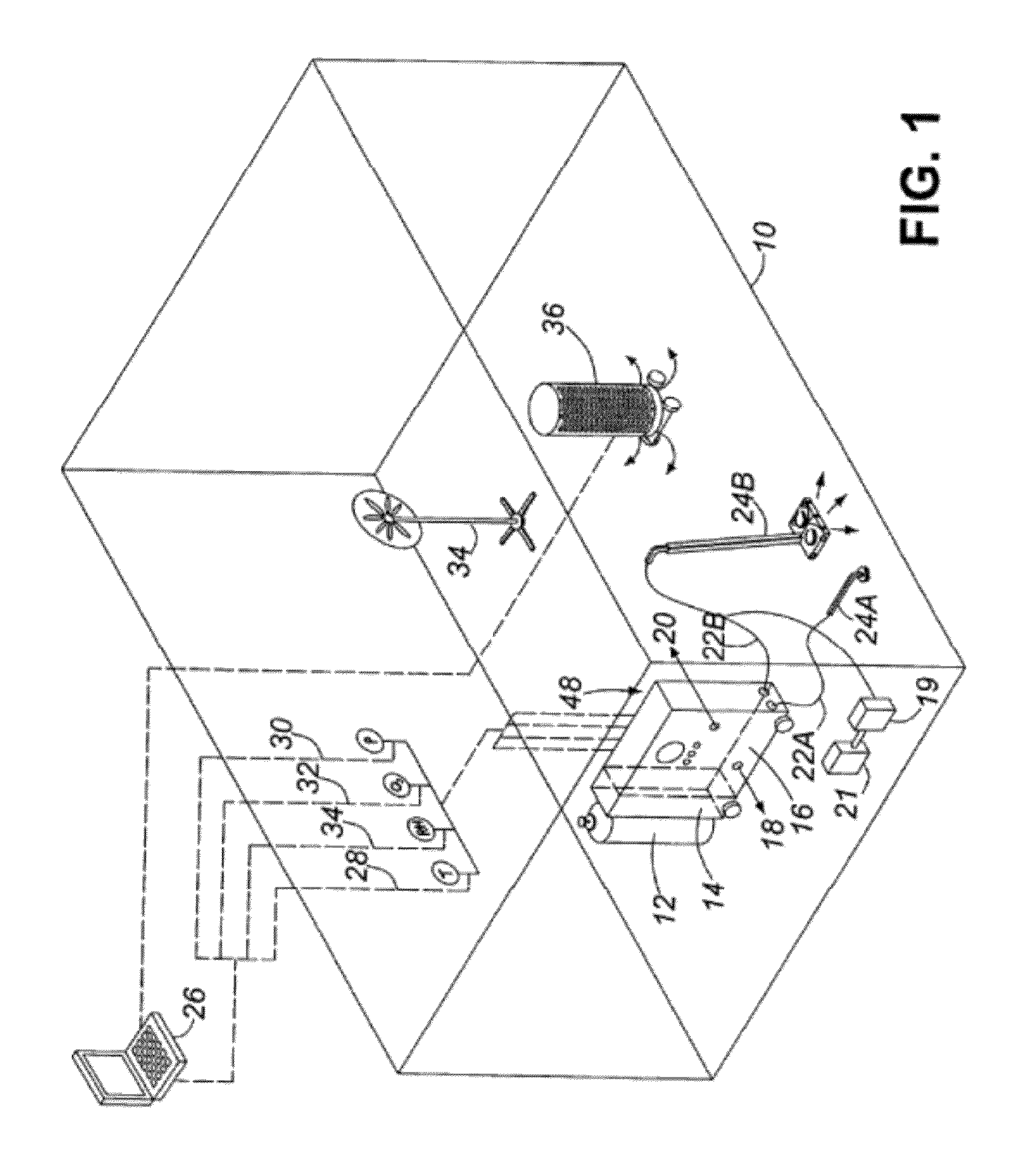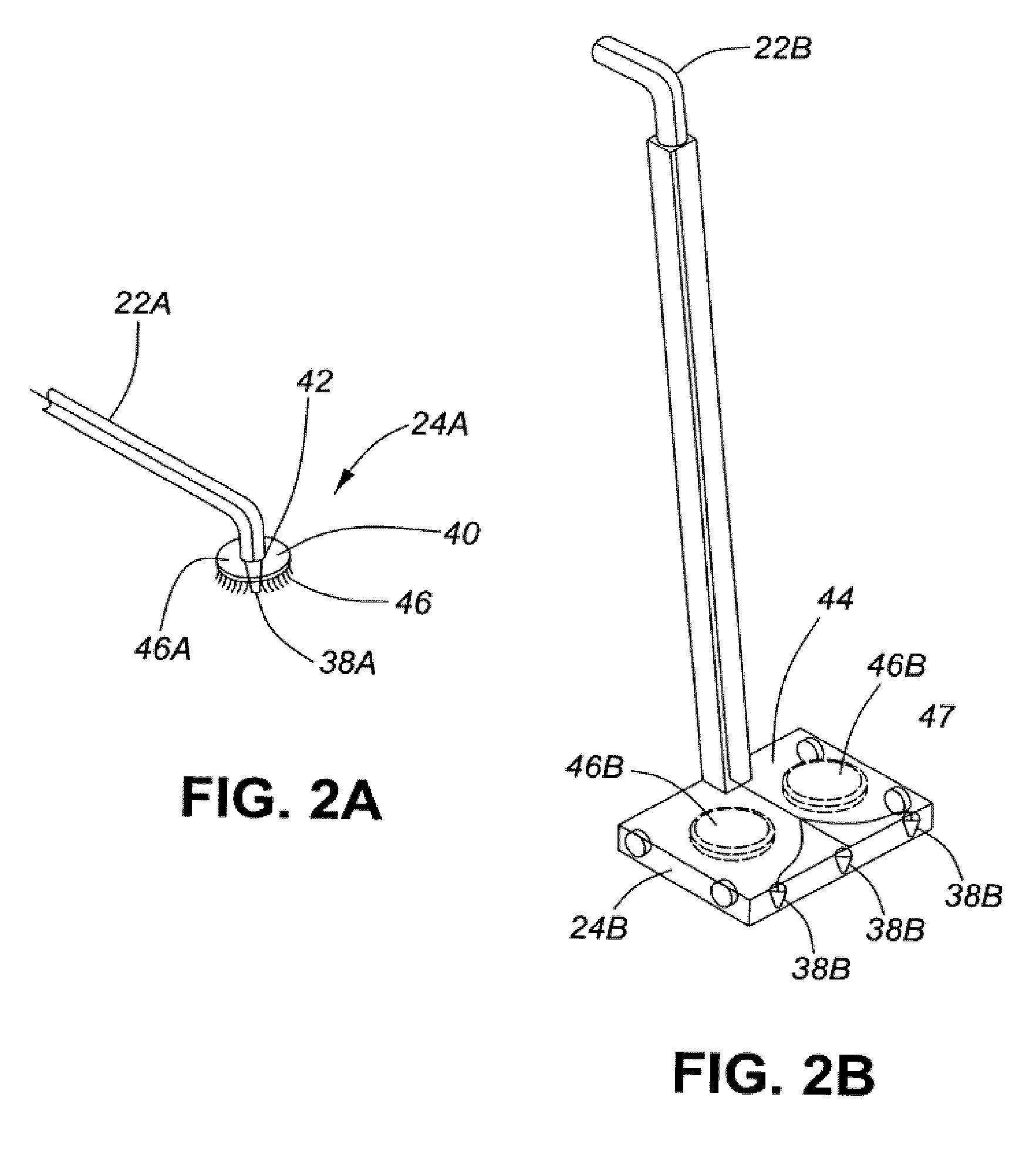Bio-terrorism counteraction using ozone and hydrogen peroxide
a technology of ozone and hydrogen peroxide, applied in the field of bacteria infection, can solve the problems of vhp, time-consuming and costly clean-up, and relative slow-acting speed
- Summary
- Abstract
- Description
- Claims
- Application Information
AI Technical Summary
Benefits of technology
Problems solved by technology
Method used
Image
Examples
experimental examples
[0034]Effective and optimum conditions for use in the present invention were determined using a laboratory apparatus as generally illustrated in FIG. 4 of the accompanying drawings.
[0035]A single pure colony of Bacillus subtilis, the surrogate for anthrax, was inoculated to a Columbia agar plate with 5% sheep's blood. They were incubated at 35° C. in room air for 18-24 hours. From the plate, 4-5 isolated colonies were selected, and suspended in tryptic soy broth to achieve a 0.5 McFarland turbidity standard (1.5×108 cfu / ml) measured using a spectrophotometer. Inoculum was prepared by performing a series of serial dilutions of 0.9 ml 0.85 NaCl broth with 0.1 ml of original 0.5 McFarland inoculum (6×10 fold) to give solutions of 10−1, 10−2, 10−3, 10−4, 10−5, 10−6 and 10−7 cfu / mL.
[0036]Organisms were plated out in triplicate, 0.1 ml of each solution being spread over the surface of Columbia sheep's blood agar plates. Two sets of 12 plates were subjected to ozone / oxygen exposure at pres...
example 1
[0041]Table 1 below provides a summary of experiments, whereby combinations of ozone, H2O2, humidity and exposure time were evaluated in terms of the ability to eliminate Bacillus subtilis when artificially applied as a biofilm onto non-porous surfaces such as stainless steel discs.
[0042]The steel discs for testing and the agar plates for testing were prepared, exposed and tested as described in the previous Example, with exposure conditions shown in Table 1 below. In some cases, indicated as “chamber”, the tests were conducted with an apparatus generally as illustrated in FIG. 4. In other cases indicated as “room”, the tests were conducted by exposing the disks and plates in a closed room, as generally illustrated in FIG. 1.
[0043]Table 1 also reports a period of post exposure (PEEP), in minutes, which is the time interval between the ozone / peroxide exposure termination and the start of the procedure for determining the results. This simulates real practice in disinfecting rooms whe...
example 2
[0045]Another series of experiments was conducted with the same Bacillus subtilis strain, but deposited onto fibrous carpet samples instead of steel discs. The carpet samples for testing and the agar plates for testing were prepared and tested as described for the steel discs above.
[0046]In the first run, a control, the Bacillus-carrying carpet sample was suspended in a room as depicted in FIG. 1, in an atmosphere containing no ozone and no hydrogen peroxide. After incubating a sample from the product and serial diluting as described, the viable colonies of Bacillus at 10-fold dilution were too numerous to count. At dilution 102, a count of 227 was registered. At dilution 103, the count was 15 and at dilution 104 the count was 1.
[0047]In the second run, a Bacillus-carrying carpet sample was suspended as before but in an atmosphere containing 80 ppm ozone, 1% hydrogen peroxide and 80% relative humidity, the atmosphere being blown at the sample with a fan to cause physical agitation a...
PUM
| Property | Measurement | Unit |
|---|---|---|
| pressure | aaaaa | aaaaa |
| humidity | aaaaa | aaaaa |
| temperature | aaaaa | aaaaa |
Abstract
Description
Claims
Application Information
 Login to View More
Login to View More - R&D
- Intellectual Property
- Life Sciences
- Materials
- Tech Scout
- Unparalleled Data Quality
- Higher Quality Content
- 60% Fewer Hallucinations
Browse by: Latest US Patents, China's latest patents, Technical Efficacy Thesaurus, Application Domain, Technology Topic, Popular Technical Reports.
© 2025 PatSnap. All rights reserved.Legal|Privacy policy|Modern Slavery Act Transparency Statement|Sitemap|About US| Contact US: help@patsnap.com



